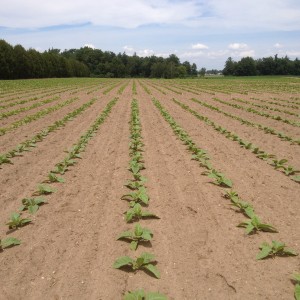Most crops are showing good progress at this time. The after effects of sandblasting on plants in open areas of fields from high winds at planting and early last week can be seen in some fields. The affected plants have been setback and are smaller, but will recover. Otherwise most crops appear quite uniform.
Most areas have seen a considerable amount of rain in just over two weeks. At Tillsonburg, rainfall from May 30th to June 15th has totalled 132.8 mm (5.23 in). No doubt there has been some leaching of nitrogen since transplanting. With side-dressing approaching, there will likely need to be some compensation.
To date there have been few field problems reported.
During replanting there were complaints of white grubs and cutworms causing damage to plants.
Injury from high salts, caused by one of the fertilizer bands at transplanting being too close to the plants, has been another problem encountered. Wet soil conditions have helped in this case to reduce the effects of the high salts being caused by the closeness of the fertilizer band to the plants.
Injury from Black Root Rot, caused by the fungus Thielaviopsis basicola, has been seen as another problem on plants in the field. Typical symptoms are uneven plant growth with the slower growing plants having dark lesions on the roots. In one case, the infected plants were grown in styrofoam plug trays in the greenhouse prior to transplanting. Unless the Styrofoam plug trays are properly sterilized following use each year, it is not uncommon for the fungus to build up in the trays and infect the plants. Disinfection of Styrofoam plug trays with steam is advised to control Black Root Rot. For more information on Black Root Rot and its control, please refer to the technical bulletin entitled “Tobacco Pests and Disorders in the Field – Black Root Rot” posted in the Plant Protection area of this website.
There continues to be only one report of Blue Mold in tobacco from the United States. This report came from Greeneville, Tennessee on June 2, where Blue Mold was found in greenhouses and in plants that had gone out to the field earlier from these greenhouses. Up until now there have been no reports of Blue Mold in Ontario. Growers should routinely scout fields and any remaining plants in greenhouses for signs of Blue Mold. Information about identification of Blue Mold and its control can be found in the technical bulletin entitled “Tobacco Pests and Disorders in the Field – Blue Mold” posted in the Plant Protection area of this website and in OMAFRA publications 842 and 843. If you find Blue Mold, please report it immediately.
Post prepared and sent by Canadian Tobacco Research Foundation
Mailing Address: CTRF, P.O. Box 322, Tillsonburg, ON N4G 4H5
Telephone: 519-842-8997
Web Address: http://ctrf1.com


